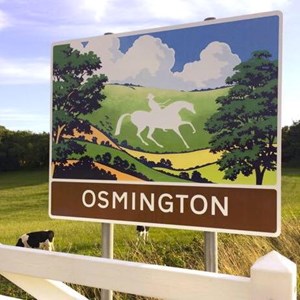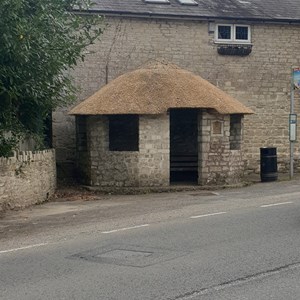Home
An Introduction to Osmington and the History of the Village
In the period 933AD to 940AD King Athelstan gave the village of Osmyngton to the Abbey of Milton.
In 964AD the reform of the monasteries replaced secular priests with monks led by an abbot.
At the time of the Doomsday book the monks at Osmington were granted by Henry I,
"possessions therein enumerated with all liberties, free customs and acquittances, the right of soc, sac, tol, team, and infangnetheof, waif, assize of bread and ale, gallows, pillory, and all other appurtenances". The Abbey of Milton owned Osmington for the next 500 years until the dissolution of the monasteries by the Tudors.
Elizabeth I gave Osmington to her kinsman and member of her privy council, Sir John Ashley. Sir John was a distant relation of Queen Elizabeth I through his mother. She was the sister-in-law of Elizabeth's great-uncle, Sir James Boleyn.
The farm in Osmington was given to George Watkins by Elizabeth I and was then passed to Lord Petre and then to The Sheldons of Weston in Warwickshire.
Daniel Sheldon in 1695 sold his lands to Awnsham Churchill a bookseller and MP in the reign of Queen Anne; he had acquired a large area of land in Osmington, Ringstead and Poxwell.
Osmington passed through the Churchill family to his great grandson William Churchill Esq of Henbury. He sold the farm to Mr Hitt of Beaminster (Hitt's farm) and latterly with the rest of the village lands to Robert Serrell Wood in 1745.
Robert Serrell Wood had one son also the Reverend Robert Serrell Wood (1779-1812) who pre-deceased him by two years and so he left the majority of the village lands to his two grandsons, Edward Atkyns Wood (1810 - 1892) and the elder brother Robert Serrell Wood (1808-1853).
Mary Kempe was the only descendant of the Serrell Wood family and lived in the village until her death in January 2022, her family having sold the majority of the larger estate properties during the mid-20th Century.
More info: www.Osmington-history.co.uk
Places of interest
Memorial Bus Shelter (National Grid Reference:SY7257182857)
The thatched village bus shelter opposite the pub is a building of historical interest; it was built by the parents of David Edward Parry-Jones who fought in World War II and is therefore now classified as a war memorial.
David Parry- Jones was their only son and was survived by his elder sister Daphne. The Parry-Jones family lived at Greensleaves on Church lane in the late 1930s to 50's
He fought in WW2 as a Lieutenant in the 1st battalion Rifle brigade and died near Caen on 3 August 1944.
The Osmington White Horse was carved out of the hillside around 1808 in honour of King George III’s many visits to the locality, in 2011 the White Horse was significantly restored and a viewing platform opened. Details of the project can be viewed at www.osmingtonwhitehorse.info
The Old Vicarage (National Grid Reference:SY 72456 82934)
An imposing early 19th Century stone building, famously inhabited by John Constable and his wife for their honeymoon.
St Osmund’s Church (National Grid Reference:SY 72419 82980)
Built predominantely in 1846 the church has a Norman 15th Century tower; the font is 12th Century. There is a monument to the Warham family, which contains their shield of arms and the sanctuary commemorates Archdeacon John Fisher.
The White House (National Grid Reference:SY 72438 82892)
A detached private dwelling built of stone in 1840 previously known as the Elms. Formerly owned by the cousin of General Haig
The Beehive, Letterbox cottage, Jasmine Cottage (National Grid Reference:SY 72467 83105)
Occupying the centre of the village these houses were the traditional shops for the village during the 18th and 19th century. The Beehive was used for collecting tolls for those using the road from the village to Preston and Poxwell. The other houses were most recently the Post office and village shop, but prior to that housed weavers, blacksmiths, a bakery.
Stonelane cottage (National Grid Reference:SY 72492 83042)
Early 18th Century thatched cottage restored in 1930 by the internationally renowned painter Talbot Hughes, whose grave can be found in the grounds of St Osmunds church.
The Phoenix (National Grid Reference:SY 72428 83254)
A mid 18th century detached cottage.
Charity Farm & Forge (National Grid Reference:SY 72396 83274)
The longhouse style farmhouse is the oldest surviving building in the village built in the late 16th Century formerly the village forge. Charity farm was purchased in 1665 by the Corporation of Weymouth and Melcombe Regis, with a bequest from Sir Samuel Mico, who intended the rent to be devoted to an annual sermon and to the relief of the poor.
Osmington House (National Grid Reference:SY 72688 83135)
Built by the Serrell-Wood family in the 1850’s dressed in Portland stone. The house is Grade II listed with Roman Doric piers and columns. Split into three private residences it nestles in a quiet location on the Old Roman road.
Roman road and settlement (National Grid Reference:SY 72688 83135)
The unmade track leads to Pixon barn on the edge of Poxell, this route was the former main route to Wareham before the main road was built in 1856. In the field opposite Pixon barn are archeological remains of a Roman settlement.
East Farm (National Grid Reference:SY 72590 82868)
A 17th Century thatched farmhouse now split into several private dwellings.
Osmington Mills & Ringstead
Osmington Mills was initially popular for the spring water, which was reputed to cure eye ailments. More recent history has been based on stories of smuggling and the challenges the coastguard encountered trying to keep law and order. The Smuggler’s Inn pub has a history of good food and makes a pleasant stop on any walk along the coast here.
Walks along the coast path between Osmington Mills and Ringstead bay open up beautiful secret coastline, which was the inspiration for the poem Bright Star by John Keats.
The Spanish armarda was finally defeated off this shoreline in 1588.
Why people visit
Osmington is a chocolate box cottage village, made famous by the White horse carved into the hill. The association with the Painter John Constable has long drawn visitors based on his two paintings of the area in 1816 – a view of the village with the Church and Ringstead bay. He spent his honeymoon at the Vicarage, the guest of the Rev Fisher, a great friend and fellow painter.
Outdoor recreation opportunities
Walking/Hiking
Many visitors to the area do not realise there are some fantastic coastal path walks around the village and along the Ridgeway allowing a circular route of Weymouth bay, the White horse hills and down to Osmington Mills and Ringstead. These are shown on Ordnance survey map OL15:Purbeck & South Dorset. Grid location SY7257 8295.


